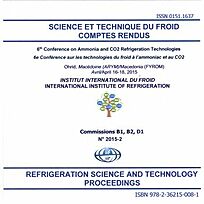
IIR document
Navigating the regulatory environment and opportunities for new technologies in the U.S.
Number: pap. n. 50
Author(s) : SMITH E.
Summary
While Europe and Australia have been leading in the phase out of fluorinated gases, the United States has been lagging in the development of regulations that will govern the orderly reduction and phase out of F-gases. In the United States, there are two things that are required in order to successfully halt the use of substances such as F-gases: the first is the political will to do so; and the second is the legislative and regulatory process that allows those who have a stake in the outcome—who are generally described as stakeholders—to voice their concerns about how such regulations will affect the area the stakeholders represent. In the case of F-gases, the stakeholders include policy makers, industry interest groups such as air conditioning equipment manufacturers, insulation manufacturers, manufacturers who use aerosols, chemical manufacturers, professional and trade associations such as AHRI, IIAR and ASHRAE, environmental groups such as Greenpeace, and end users of refrigerants and expanding agents. While it is clear that the U.S. government plans to take more action on F-gases beyond the phase out of R-22, it is not clear what the specific actions will be or how soon they will occur. This has left end users with many questions about how they should proceed.
Available documents
Format PDF
Pages: 8 p.
Available
Public price
20 €
Member price*
Free
* Best rate depending on membership category (see the detailed benefits of individual and corporate memberships).
Details
- Original title: Navigating the regulatory environment and opportunities for new technologies in the U.S.
- Record ID : 30014691
- Languages: English
- Subject: Regulation, General information, HFCs alternatives
- Source: 6th Conference on Ammonia and CO2 Refrigeration Technology. Proceedings: Ohrid, North Macedonia, April 16-18, 2015.
- Publication date: 2015/04/16
Links
See other articles from the proceedings (53)
See the conference proceedings
Indexing
-
Methodological approaches for the compilation o...
- Author(s) : GSCHREY B., SCHWARZ W.
- Date : 2013/09/02
- Languages : English
- Source: Compressors 2013: 8th International Conference on Compressors and Coolants.
- Formats : PDF
View record
-
Controlling Freon gases by reconstruction of th...
- Author(s) : AKSIC N., GORDIC D.
- Date : 2017/12/06
- Languages : English
- Source: 48th International HVAC&R Congress and Exhibition.
- Formats : PDF
View record
-
Policy contexts and implications of F-Gas refri...
- Author(s) : LAIL D.
- Date : 2018/09
- Languages : English
- Source: 1st IIR international conference on the application of HFO refrigerants, Birmingham, September 2-5 2018.
- Formats : PDF
View record
-
Study of European F-gas regulation impact on re...
- Author(s) : CAVALIER G., VALET O., HARDY M., BOUREZ D., FERTEL C.
- Date : 2023/08/21
- Languages : English
- Source: Proceedings of the 26th IIR International Congress of Refrigeration: Paris , France, August 21-25, 2023.
- Formats : PDF
View record
-
Future refrigerant mix estimates as a result of...
- Author(s) : MAKHNATCH P., MOTA BABILONI A., KHODABANDEH R.
- Date : 2019/08/24
- Languages : English
- Source: Proceedings of the 25th IIR International Congress of Refrigeration: Montréal , Canada, August 24-30, 2019.
- Formats : PDF
View record
